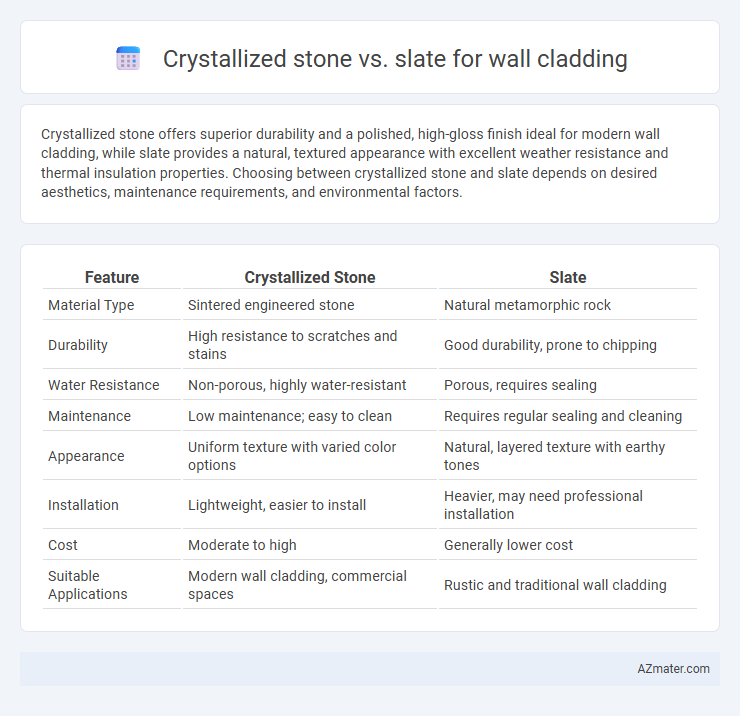Crystallized stone offers superior durability and a polished, high-gloss finish ideal for modern wall cladding, while slate provides a natural, textured appearance with excellent weather resistance and thermal insulation properties. Choosing between crystallized stone and slate depends on desired aesthetics, maintenance requirements, and environmental factors.
Table of Comparison
| Feature | Crystallized Stone | Slate |
|---|---|---|
| Material Type | Sintered engineered stone | Natural metamorphic rock |
| Durability | High resistance to scratches and stains | Good durability, prone to chipping |
| Water Resistance | Non-porous, highly water-resistant | Porous, requires sealing |
| Maintenance | Low maintenance; easy to clean | Requires regular sealing and cleaning |
| Appearance | Uniform texture with varied color options | Natural, layered texture with earthy tones |
| Installation | Lightweight, easier to install | Heavier, may need professional installation |
| Cost | Moderate to high | Generally lower cost |
| Suitable Applications | Modern wall cladding, commercial spaces | Rustic and traditional wall cladding |
Introduction to Crystallized Stone and Slate Wall Cladding
Crystallized stone wall cladding offers exceptional durability and a glossy, polished surface achieved through high-temperature sintering and crystallization processes, making it ideal for modern architectural applications. Slate wall cladding features natural, layered textures and earthy tones, providing a rustic aesthetic with strong resistance to weather and wear due to its metamorphic origin. Both materials provide unique visual appeal and long-lasting performance, but crystallized stone emphasizes high-tech manufacturing precision while slate highlights natural elegance and ruggedness.
Composition and Formation: Crystallized Stone vs Slate
Crystallized stone for wall cladding is formed through a metamorphic process where intense heat and pressure cause recrystallization of minerals, resulting in a dense, interlocking crystalline structure typically composed of quartz, feldspar, and mica. In contrast, slate originates from the low-grade metamorphism of shale, sedimentary rock mainly composed of clay minerals and fine-grained quartz, leading to its characteristic foliation and layered texture. The distinct mineral composition and formation processes influence their durability, appearance, and suitability for exterior wall cladding applications.
Aesthetic Appeal: Visual Differences
Crystallized stone wall cladding exhibits a rich, glossy finish with intricate mineral patterns and vibrant color variations that create a luxurious and eye-catching surface. Slate offers a more subdued, matte texture with natural clefts and consistent earthy tones, providing a rustic and timeless look. The visual differences make crystallized stone ideal for contemporary designs seeking a bold statement, while slate suits classic or natural-themed interiors emphasizing subtle elegance.
Durability & Strength Comparison
Crystallized stone offers superior hardness and resistance to scratches compared to slate, making it highly durable for wall cladding in high-traffic or exposed environments. Slate, while naturally strong and weather-resistant, is more prone to chipping and requires periodic sealing to maintain structural integrity. The dense composition of crystallized stone contributes to its higher compressive strength, ensuring longer-lasting performance under mechanical stress.
Maintenance Requirements for Both Materials
Crystallized stone requires minimal maintenance, as it is resistant to stains, scratches, and moisture, making it ideal for wall cladding in both indoor and outdoor settings. Slate, while durable, demands more upkeep due to its porous surface, requiring regular sealing to prevent water damage, staining, and efflorescence. Proper maintenance of slate includes periodic cleaning with pH-neutral products to preserve its natural texture and color over time.
Weather and Moisture Resistance
Crystallized stone offers superior weather resistance due to its dense, non-porous surface that effectively repels moisture and resists freezing temperatures, preventing cracks and erosion. Slate, while durable, is more porous and can absorb water, making it susceptible to weathering and freeze-thaw damage in harsh climates. For wall cladding exposed to extreme weather conditions, crystallized stone provides enhanced longevity and minimal maintenance compared to traditional slate.
Installation Process: Crystallized Stone vs Slate
Crystallized stone wall cladding offers a lighter, more uniform material that simplifies installation with quicker cutting and handling compared to the heavier and denser slate. Slate requires specialized tools and more labor-intensive processes due to its natural layers and brittleness, increasing installation time and complexity. The adhesive compatibility and surface preparation for crystallized stone are generally more straightforward, making it a preferred choice for faster and cleaner wall cladding projects.
Cost Analysis and Budget Considerations
Crystallized stone wall cladding typically incurs higher initial costs due to its intricate production process and premium aesthetic appeal, making it suitable for high-end projects with flexible budgets. Slate offers a more budget-friendly option with lower material and installation expenses, providing durability and natural texture ideal for cost-conscious renovations. Evaluating project scope and long-term maintenance expenses is essential to balance upfront investment against desired visual impact and durability.
Eco-Friendliness and Sustainability
Crystallized stone offers high durability and minimal processing, reducing environmental impact compared to energy-intensive materials, while slate is a natural, recyclable stone with low carbon emissions throughout its lifecycle. Both materials provide sustainable options for wall cladding, but crystallized stone often incorporates recycled content and can exhibit better resource efficiency. Choosing between crystallized stone and slate depends on project goals for ecological footprint, durability, and material sourcing transparency.
Choosing the Right Material for Your Wall Cladding
Crystallized stone offers exceptional durability and a polished aesthetic, making it ideal for modern wall cladding projects requiring long-lasting elegance. Slate provides natural texture and earthy tones, perfect for rustic or traditional designs while offering excellent weather resistance and low maintenance. Choosing the right material depends on desired visual impact, environmental exposure, and maintenance preferences to ensure optimal performance and style for your wall cladding.

Infographic: Crystallized stone vs Slate for Wall Cladding
 azmater.com
azmater.com